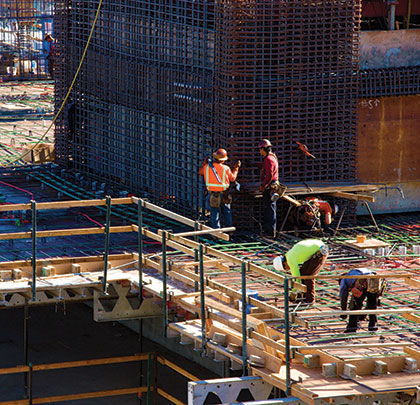The Greek philosopher Heraclitus once wrote that nothing endures but change. That adage certainly holds true in the construction industry. Nearly every construction project will require changes to its scope or duration before it’s completed. Common causes of changes include unforeseen site conditions, an owner’s new vision for the completed project, and errors and inconsistencies in the plans and specifications. Disagreements invariably develop regarding the value of the changed work and the time required to perform it.
THE CONSTRUCTION CONTRACT
A well-drafted construction contract will contain provisions governing the methods by which changes to the work may be negotiated, compensated, and even compelled. Since changes cannot be avoided, contractors should understand the importance of carefully analyzing the provisions that will dictate how changes to the work are implemented once the need arises. Because of the pervasiveness of change clauses in construction contracts, savvy contractors should be familiar with the different types of change provisions they will encounter among different projects. Contract clauses governing changes can be burdensome, and if their terms are not followed, a contractor may face challenges recovering payments for its extra work performed. Where possible, provisions regulating changes to the work can and should be negotiated.
Generally, more specific and complete terms in the change clause result in less confusion and fewer disputes as the project moves forward. At its core, a change provision should provide a mechanism by which the owner can order a change and the contractor is compensated for its performance of the changed work. However, other terms are often negotiated and included in the change clause. For example, contractors should negotiate to ensure that the change clause provides for contractor-proposed change orders, rather than only for changes originating with the owner or its design professional.
PRACTICABLE TERMS
Contractors should bargain for practicable terms that will control the form and timing of submitting proposed change orders to the owner. When determining a workable time period, the contractor should consider its own staffing capacity along with the location and availability of the individual to whom proposed change orders must be presented. Recognize any formal procedural requirements that must be met in order for the owner to approve a proposed change and the toll a delay in its approval will take on the project schedule. Contractors should also be certain to include all required documentation supporting any proposed changes. If a contractor fails to submit its proposals in the required form and within the designated time frame, the owner may be entitled to delay or withhold payment for the extra work that was the subject of the proposed change.
When reviewing and preparing to negotiate the terms of an agreement, a contractor should always determine whether it contains a “no damages for delay” clause. These clauses are increasingly common in construction contracts, and their effects on contractors have become more severe with recent court decisions. Owner-initiated changes to the work frequently have a ripple effect on the schedule of the project as a whole. When an owner requires a change that delays the schedule of the project, the contractor may be forced to expend additional resources as a consequence of the owner’s actions. A no-damages clause in the contract may limit or waive a contractor’s ability to recover damages from the owner, even if the delays were entirely the result of the owner’s conduct. Contractors should negotiate against the inclusion of provisions that limit or waive their entitlement to recover delay damages for an owner’s negligence, breach of contract, or for “acts of god.”
CHANGE DIRECTIVE
A construction change directive is another tool available to owners wishing to change the work on a project. An owner may issue a change directive if it is unable to agree with the contractor to the terms under which the contractor will perform changed work, often with regard to compensation. When an owner issues a change directive, the contractor is required to proceed immediately with the changed work, leaving some details like cost to be determined by the design professional or calculated at a later time. Although the expediency with which change directives may be issued can keep the project moving forward, their use also has drawbacks. Performing work before compensation has been determined or agreed upon may put a contractor in a precarious financial position. Therefore, a contractor should give careful consideration to the conditions under which an owner is entitled to issue a construction change directive and the procedures outlined for reaching an agreement on compensation.
In conclusion, changes to work can transform a profitable and straightforward project into a disaster for an unwary contractor. A contractor can protect itself from problematic change clause provisions by carefully considering, before the contract is executed, precisely what the provisions require of the contractor. By anticipating changes to the work and negotiating contract terms that will facilitate the efficient implementation of those changes, a contractor can ensure that its reputation and financial interests are protected. ■
About the Authors:
Jeffrey S. Chapman is a shareholder and Chris Scifres is an associate with Ford Nassen (www.fordnassen.com), which is nationally recognized in the construction industry and one of the largest construction law firms in Texas. Mr. Chapman and Mr. Scifres practice construction law with a focus on the litigation and resolution of construction disputes. In addition, they regularly assist clients in preparing and negotiating contracts and other procurement documentation. Mr. Chapman can be reached at jschapman@fordnassen.com or 512.275.1782. Mr. Scifres can be reached at cascifres@fordnassen.com or 214.523.5100.
_________________________________________________________________________
Modern Contractor Solutions, October 2013
Did you enjoy this article?
Subscribe to the FREE Digital Edition of Modern Contractor Solutions magazine.

Negotiating Change Provisions, Change Orders, and Change Directives


